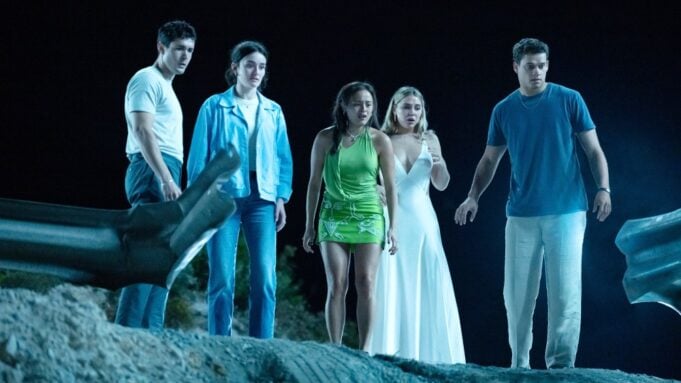By the time “I Know What You Did Last Summer” came out in 1997, the slasher-movie genre was 25 years old, and everything that could be done to it had been done. It had arisen, from ragtag nightmares like “The Last House on the Left” (1972), out of the crude raw compost of the drive-in/grindhouse world of the early ’70s. It had shocked and scared and scandalized people. It had been raised to an unnerving level of Hitchcockian art in “The Texas Chain Saw Massacre” (1974). It had been mainstreamed with “Halloween” (1978), then numbingly formulized with “Friday the 13th” and its sequels. It had been given a disturbing feminist spin in “I Spit on Your Grave” (1978). And then, in the ’80s, it became a knowingly flamboyant homicidal freak-show burlesque — with the “Nightmare on Elm Street” films, and with a hundred tacky extreme Z-movie knockoffs.
The novelty of “I Know What You Did Last Summer” wasn’t its hulking psycho killer, who was a less scary version of Michael Myers or Jason Vorhees dressed like the Gorton’s fisherman mascot, or even its premise, which was that four teenagers in Southport, N.C., walk away from the fatal car accident they caused, so that when they start to be murdered they’re in effect being stalked by their guilt. After all, when did the slasher genre ever need an excuse to kill pretty young things in ticklishly gory ways? The whole point of the genre was to slaughter kids…simply for the crime of existing.
No, the “innovation” of “I Know What You Did Last Summer” is that it was the blood-splattering version of a glossy Hollywood youth flick, with up-to-the-minute stars like Sarah Michelle Gellar and Ryan Phillippe and Jennifer Love Hewitt and Freddie Prinze Jr. And so it marked the final evolution of the slasher genre into slightly edgy consumer product. The film was as watchable as it was forgettable (not better than that, not worse). Yet there was a touch of karma to the fact that it had been penned by Kevin Williamson, the high-cheek screenwriting wizard of “Scream” (which came out the year before). In “Scream,” Williamson sliced and diced the slasher genre itself, revealing that its audience was totally in on the joke of how much smarter they were than just about every one of these movies. “I Know What You Did Last Summer” was Williamson effectively returning the slasher movie to its pre-ironic dumb roots.
So what is there left for a remake of “I Know What You Did Last Summer” to do? The slasher genre is now 50 years old. It’s a form that has been hard to play straight for 25 of those years (though David Gordon Green’s “Halloween” franchise tried, even if he ultimately enjoyed less success than the makers of the recent “Scream” sequels). The first thing you notice about the new “I Know What You Did Last Summer,” which plays it very straight, is that there’s nothing especially grabby or unsettling about the killings. It’s the same killer we remember from the 1997 version and its sequel, the fiend in his fisherman’s cap and slicker and boots, wielding that fisherman’s hook. As staged by director Jennifer Kaytin Robinson, the murders aren’t notably scary or extreme; though the film is rated R, it feels like it could have been PG-13.
But the less-than-super-sensational, almost under-the-top quality of the slaughter is actually connected to something that the film is trying to accomplish. “I Know What You Did Last Summer” faithfully revives the set-up of the 1997 version: Our decadent youth friends, out for a night of partying, obstruct a dead-man’s-curve section of roadway, which causes a pickup truck to smash through the guard rail, and then, despite their best efforts to save the driver, the truck plunges down the mountainside. Their crime is making a pact to pretend that they were never there.
What’s different this time is that with the slasher stuff staged in a restrained way, the movie plays as even more of a whodunit. There’s a conspiracy related to the first film: The murders back then made property values plunge, but now Southport has been gentrified and turned into the “Hamptons of the South” — so the powers that be want to bury any memory of what happened 28 years ago. The New Wealth is the real theme here; that’s what the characters are really being punished for. Over the July 4th weekend, Danica (Madelyn Cline), an insanely entitled princess with a full-time therapist-and-meditation regimen, is having her bridal shower. Danica’s bestie, Ava (Chase Sui Wonders), is more important to her than her fiancé, Teddy, who’s a hip-hop Abercrombie jerk (though Tyriq Withers makes him weirdly likable). Danica and her friends are children of privilege, but as that fateful night on the roadway unfolds, they’re joined by Stevie (Sarah Pidgeon), their former high-school pal who fell out of favor with them when her father lost his money. This will figure into everything.
Love Film & TV?
Get your daily dose of everything happening in music, film and TV in Australia and abroad.
Robinson draws on influences from “Scream” to “Bodies Bodies Bodies,” and she comes up with one wild-card character — an omnisexual goth horror-podcast host played by the musician/model Gabbriette Bechtel. The film is built on our desire to see the killer unmasked, which takes it down from the mythological level of so many slasher films. (He’s not wearing a mask, but he’s always in shadow.) I appreciated that Robinson was actually trying to make a real movie out of all this. Yet it’s not a real movie. It’s a concoction impersonating one.
That said, Robinson mixes three of the original stars into her game plan, and they’re not just throwaway cameos. Jennifer Love Hewitt returns as Julie James, who is now a traumatized law professor, Freddie Prinze Jr. plays Ray Bronson as a local bar owner who carries around a brooding resentment (in his salt-and-pepper hair, Prinze evokes Frank Langella, and he’s a much more interesting actor than he was before), and Sarah Michelle Gellar shows up in a dream sequence with her weirdly relatable hauteur terrifically intact.
Do we care about any of the characters? Not a bit. It isn’t that the actors are bad; it’s that the movie’s format encourages us to want to see them get killed — because there’s really nothing at stake outside of that. The revelation of the killer’s identity owes an obvious debt to the “Scream” films and feels just as arbitrary, though maybe less fun. If nothing else, “I Know What You Did Last Summer” delivers on the nostalgic promise of its title, but that’s a qualified compliment. The film should have been called “I Know What You Saw at the Megaplex Last Century, and You’re Still Seeing It.”
From Variety US































